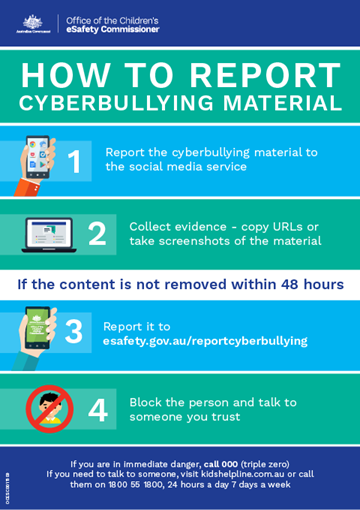FACTSHEETS
What is cyberbullying
Cyberbullying is the use of technology to bully a person or group with the intent to hurt them socially, psychologically or even physically.
Right now there are many young people being cyberbullied. By reporting it, talking about it and supporting each other we can stop it.
What does cyberbullying look like?
Cyberbullying can occur in many ways, including:
- abusive texts and emails
- hurtful messages, images or videos
- imitating others online
- excluding others online
- humiliating others online
- nasty online gossip and chat.
I am being cyberbullied—how do I stop it?
- talk to someone you trust straight away—like a parent, sibling, uncle/aunt, teacher or friend, or contact Kids Helpline
- don’t retaliate or respond—they might use it against you
- block the bully and change your privacy settings
- report the abuse to the service and get others to as well
- collect the evidence—keep mobile phone messages, take screen shots and print emails or social networking conversations
- do something you enjoy—catch-up with friends, listen to good music, watch a good show or chat online to people you can trust
- remember you didn’t ask for this—nobody deserves to be bullied and you will get through this.
School support
Most schools have policies in place to address cyberbullying and should be able to provide support to you and other students, no matter whether the bullying is from a student at your school or not. Talk to a teacher or counsellor you like and trust.
What if a friend is being cyberbullied?
If you have a friend or know someone at school who is being cyberbullied:
- don’t join in—don’t comment on posts, images or videos
- don’t forward or share posts, images or videos that will hurt others
- leave negative groups and conversations
- report bullying to someone that can help—this can be an anonymous report to a parent or teacher
- if you are confident, call others on their bullying and ask them to stop—’Enough. This isn’t funny’
- support your friend online and offline—’I heard about the posts—you don’t deserve it. I’m here for you.’
Lodging a cyberbullying complaint
Also check the related topics:
Cyberbullying Cyberbullying






